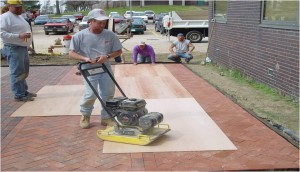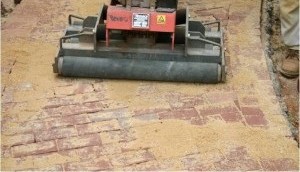Architectural Specifications
Whitacre Greer’s dry pressed, bevel-edge pavers are an innovative product developed from more than 40 years of press-forming experience. Use the following Whitacre Greer clay paver specifications and details when choosing these products for your project.
These popular pavers offer permanent rich colors that will not fade, superior freeze-thaw resistance, minimal chipping and exceptional dimensional stability. The entire line of pavers is available with side lugs for automatic spacing in laying applications. Straight edge pavers are also available in all thicknesses.
Whitacre Greer dry-pressed pavers are available in a variety of shapes and sizes, from 1-1/2″ to 3-1/2″ thick for paving roadway’s, patios and driveways, with special sizes for garden projects.Traditional and unique sizes encourage design flexibility and greatly increase the number of potential installation patterns.
Landscape Architects, Architects, Engineers and Design Professionals – use the information below to craft your specification for Whitacre Greer pavers. Provided specifications and installation details are guidelines developed from the Brick Industry Association and industry best practices. Consult a segmental paver specialist for details applicable to your project.
Clay Paver Specifications
Clay Paver Sand Set Installation Specifications (PDF)
Sand Setting Bed Flexible Base (PDF) (DWF) (DWG)
Sand Setting Bed with Rigid Base (PDF) (DWF) (DWG)
Clay Paver Permeable Installation
Clay Paver Permeable Installation Specification (PDF)
Permeable Paver – Full Exfiltration (PDF) (DWF) (DWG)
Permeable Paver – Partial Exfiltration (PDF) (DWF) (DWG)
Permeable Paver – No Exfiltration (PDF) (DWF) (DWG)
Clay Paver Bituminous Setting System
Clay Paver Bituminous Setting Specification (PDF)
Bituminous Setting Bed with Concrete Base (PDF) (DWF) (DWG)
Clay Paver Installation Best Practices
Clay Paver Best Practices (PDF)
Brick Industry Association Technical Notes and Publications
Technical Note 14 Paving Systems Using Clay Pavers
Technical Note 14A Paving Systems Using Clay Pavers on a Sand Setting Bed
Technical Note 14B Paving Systems Using Clay Pavers on a Bituminous Setting Bed
Technical Note 14C Paving Systems Using Clay Pavers in a Mortar Setting Bed
Technical Note 14D Permeable Clay Brick Pavements
Technical Note 14E Accessible Clay Brick Pavements
Brick Industry Association Flexible Vehicular Brick Paving – A Heavy Duty Applications Guide
Brick Brief Clay Pavers for Fire Lanes and H-20 Loadings
Brick Industry Association White Paper
Additional Whitacre Greer Resources
Paver Slip and Skid Resistance Data
Industry Links
Note to Specifiers
Whitacre Greer strongly suggested that the following items be included in your documents:
Installer qualifications: three years experience with at least 75-100,000 square feet installed. Successful completion of five similar brick paver installations similar in design which are to be documented. Installer has included the specified product(s) in their bid and they have read and understand the contents of ASTM C 902 and/or C 1272 as applicable.
Mock ups must be done showing the quality of work expected. Work shall not start until the mock up is approved by the architect.
Pre-installation meetings are recommended. Include paver distributor or manufacturer’s representative.
Industry installation standards:
Provide 1/16″ – 3/16″ sand filled joints between pavers.
String or chalk lines must be used to keep paver bond lines straight and true. The straight and true bond lines shall not deviate more than +/- 1/2″ over 50 feet. (The correct way to install is to establish a center line working outward setting parallel string lines every 2 to 6 feet, depending on the area, to continuously check and adjust paver bond lines.)
Surface flatness not to exceed +/- 3/8″ over 10 feet.
Lippage not to exceed 1/8″ between adjacent pavers.
No work is to be done when any materials are wet or frozen.
Installer must blend from a minimum of three pallets of brick pavers.
Bituminous set pavers can and should be rolled or compacted to achieve full bond with the setting bed, reduce lippage and improve the overall flatness of the surface. See Brick Industry Association Technical Note 14B (pg. 11) and Flexible Vehicular Brick Paving Guide (pg. 36). Protect pavers by using a rubber roller or a 4-5000 LBF plate tamper with a protective mat attached. Plywood may also be utilized and is preferred to sand which may damage the surface of the pavers.
 Whitacre Greer dry-pressed pavers conform to the applicable standard specifications for such materials adopted by the American Society for Testing and Materials C-902 and/or C-1272, Class SX, Type I, Application PS. Application PX available on request.
Whitacre Greer dry-pressed pavers conform to the applicable standard specifications for such materials adopted by the American Society for Testing and Materials C-902 and/or C-1272, Class SX, Type I, Application PS. Application PX available on request.
Colors and size within a given shipment may vary slightly due to subtle changes in clay composition and kiln firing temperatures. Pavers are sealed with a siloxane-based penetrating sealer/water proofer. All materials should inspected upon delivery.
Please contact your Whitacre Greer sales representative for assistance applying these clay paver specifications and details to your project.



